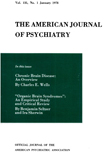A TEN-YEAR FOLLOW-UP STUDY OF ELECTROCOMA THERAPY
Abstract
1. The immediate results of ECT are generally excellent, providing marked relief of symptoms in many psychoses. This relief amounts to a recovery in a high percentage of depressed patients.
2. A 10-year follow-up of 65 patients in whom depression was the cardinal difficulty reveals that 45 were relatively well, 16 moderately or slightly improved, and 4 unchanged or worse up to the time of the last contact.
3. Recurrences are common. Thirty-two of the depressed patients have had recurrences requiring further courses of treatment. After subsequent therapy, 18 were relatively well and the condition of 14 was fair or poor.
4. Electrocoma therapy does not accelerate or retard recurrences.
5. The immediate complications were few and relatively insignificant compared to the benefits obtained. The 9- to 10-year follow-up revealed no cumulative complications; we did not encounter epilepsy, spinal deformities, or mental deterioration due to the treatment.
6. During the 9-to 10-year study there were 9 deaths, the first occurring 1 year and the last 10 years after treatment, from causes unrelated to the treatment.
7. Ambulatory ECT is effective. Properly administered by a competent psychiatrist with critical patient selection, it saves time, money, prestige, and suffering and enables a smoother integration of electrocoma therapy with other methods of treatment.
8. Present-day treatment makes it possible to administer ECT in a relatively safe, comfortable manner, removing the psychological atmosphere of shock.
9. Electrocoma therapy has proved valuable in the prevention of suicides.
10 Finally, electrocoma therapy has proved itself to be the outstanding addition to psychiatric therapy in the fifth decade of the present century. It is not a static, but a growing technique, which is being modified and improved and which should continue to help psychotic patients until newer and better procedures are introduced.
Access content
To read the fulltext, please use one of the options below to sign in or purchase access.- Personal login
- Institutional Login
- Sign in via OpenAthens
- Register for access
-
Please login/register if you wish to pair your device and check access availability.
Not a subscriber?
PsychiatryOnline subscription options offer access to the DSM-5 library, books, journals, CME, and patient resources. This all-in-one virtual library provides psychiatrists and mental health professionals with key resources for diagnosis, treatment, research, and professional development.
Need more help? PsychiatryOnline Customer Service may be reached by emailing [email protected] or by calling 800-368-5777 (in the U.S.) or 703-907-7322 (outside the U.S.).



